#Laravel Eloquent ORM
Explore tagged Tumblr posts
Text
#Laravel#Laravel Framework#PHP Laravel#Laravel 10 (or current version)#Laravel MVC#Laravel Artisan#Laravel Eloquent ORM
0 notes
Text
How online Office Systems use Laravel Eloquent Relationships
In an online office furniture system, handling data efficiently is crucial for managing products, orders, and customers. Using an ORM like Eloquent in Laravel simplifies database interactions by allowing developers to work with objects instead of raw SQL queries.
For example, retrieving all products in a category can be done with $category->products instead of writing complex SQL joins. This makes the code more readable, maintainable, and secure, reducing the risk of errors and SQL injection.
So, you can also leverage Eloquent powerful features, such as relationships and query builders, developers can build scalable and efficient applications while keeping the codebase clean and organized.
#laravel#laravel framework#Eloquent#ORM#Object Relational Mapping#object oriented programming#Database#Database relationships#office furniture#web development#scalable apps#web applications#managing data#developer tools#back end design#web design#PHP#office desks#office chairs#products#categories
0 notes
Text
Aamod ItSolutions: Crafting Custom Websites with Modern Technologies for Your Business’s Success
In today’s digital world, having an effective website is crucial for business success. Aamod ItSolutions offers expert web design, development, and marketing services that help businesses make the most of their online platforms. Our team of skilled designers and developers uses modern technologies to build custom, user-friendly, and reliable websites tailored to your specific needs.
Why Web Development Matters
A website serves as a business’s online identity. It enables businesses to reach a wider audience, engage with customers, and boost sales. A professionally developed website builds trust, enhances credibility, and positions your business as a leader in the market.
At Aamoditsolutions, we focus on delivering websites that provide excellent user experience (UX), performance, and scalability. We employ various modern technologies to ensure your site meets business goals efficiently.
Technologies We Use
Laravel: Laravel is a powerful PHP framework used for building secure, scalable web applications. It simplifies development with features like Eloquent ORM for database management and Blade templating for creating dynamic views. Laravel is great for complex applications with robust security features.
CodeIgniter: CodeIgniter is a lightweight PHP framework known for its speed and simplicity. It’s ideal for developers looking for quick setups and minimal configuration. With its MVC architecture, CodeIgniter is perfect for building fast, high-performance websites, especially when project deadlines are tight.
CakePHP: CakePHP is another PHP framework that streamlines the development process with built-in features like form validation and security components. It helps deliver web apps quickly without compromising quality. CakePHP is ideal for projects that need rapid development with a focus on database-driven applications.
Node.js: Node.js is a JavaScript runtime for building fast and scalable applications. It is especially useful for real-time web apps such as chat applications or live notifications. Node.js provides non-blocking I/O operations, enabling it to handle many simultaneous connections without performance loss.
AngularJS: AngularJS is a framework developed by Google for building dynamic, single-page applications (SPAs). Its features like two-way data binding and dependency injection make it perfect for building interactive user interfaces that update in real time without reloading the entire page.
Why Choose Aamod ItSolutions?
At AamodItSolutions, we use the latest tools and technologies to build high-performance, secure, and user-friendly websites that help you grow your business. Whether you’re a startup or a large corporation, we create custom solutions that align with your objectives.
We understand that every business has unique needs. That’s why we choose the right technology for each project to ensure optimum results. By working with us, you can expect a website that provides a seamless experience for your users and contributes to your business growth.
Let Aamod ItSolutions help you create a powerful online presence that engages customers and drives business success.
#cosplay#drew starkey#bucktommy#entrepreneur#harley quinn#jujutsu kaisen#english literature#black literature#blush#kawaii
3 notes
·
View notes
Text
Protect Your Laravel APIs: Common Vulnerabilities and Fixes
API Vulnerabilities in Laravel: What You Need to Know
As web applications evolve, securing APIs becomes a critical aspect of overall cybersecurity. Laravel, being one of the most popular PHP frameworks, provides many features to help developers create robust APIs. However, like any software, APIs in Laravel are susceptible to certain vulnerabilities that can leave your system open to attack.

In this blog post, we’ll explore common API vulnerabilities in Laravel and how you can address them, using practical coding examples. Additionally, we’ll introduce our free Website Security Scanner tool, which can help you assess and protect your web applications.
Common API Vulnerabilities in Laravel
Laravel APIs, like any other API, can suffer from common security vulnerabilities if not properly secured. Some of these vulnerabilities include:
>> SQL Injection SQL injection attacks occur when an attacker is able to manipulate an SQL query to execute arbitrary code. If a Laravel API fails to properly sanitize user inputs, this type of vulnerability can be exploited.
Example Vulnerability:
$user = DB::select("SELECT * FROM users WHERE username = '" . $request->input('username') . "'");
Solution: Laravel’s query builder automatically escapes parameters, preventing SQL injection. Use the query builder or Eloquent ORM like this:
$user = DB::table('users')->where('username', $request->input('username'))->first();
>> Cross-Site Scripting (XSS) XSS attacks happen when an attacker injects malicious scripts into web pages, which can then be executed in the browser of a user who views the page.
Example Vulnerability:
return response()->json(['message' => $request->input('message')]);
Solution: Always sanitize user input and escape any dynamic content. Laravel provides built-in XSS protection by escaping data before rendering it in views:
return response()->json(['message' => e($request->input('message'))]);
>> Improper Authentication and Authorization Without proper authentication, unauthorized users may gain access to sensitive data. Similarly, improper authorization can allow unauthorized users to perform actions they shouldn't be able to.
Example Vulnerability:
Route::post('update-profile', 'UserController@updateProfile');
Solution: Always use Laravel’s built-in authentication middleware to protect sensitive routes:
Route::middleware('auth:api')->post('update-profile', 'UserController@updateProfile');
>> Insecure API Endpoints Exposing too many endpoints or sensitive data can create a security risk. It’s important to limit access to API routes and use proper HTTP methods for each action.
Example Vulnerability:
Route::get('user-details', 'UserController@getUserDetails');
Solution: Restrict sensitive routes to authenticated users and use proper HTTP methods like GET, POST, PUT, and DELETE:
Route::middleware('auth:api')->get('user-details', 'UserController@getUserDetails');
How to Use Our Free Website Security Checker Tool
If you're unsure about the security posture of your Laravel API or any other web application, we offer a free Website Security Checker tool. This tool allows you to perform an automatic security scan on your website to detect vulnerabilities, including API security flaws.
Step 1: Visit our free Website Security Checker at https://free.pentesttesting.com. Step 2: Enter your website URL and click "Start Test". Step 3: Review the comprehensive vulnerability assessment report to identify areas that need attention.
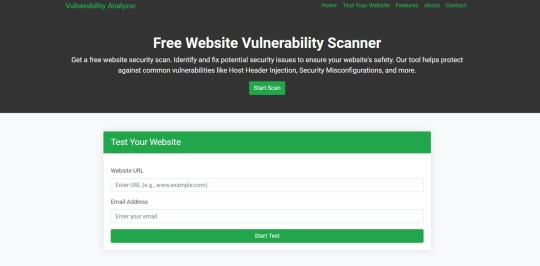
Screenshot of the free tools webpage where you can access security assessment tools.
Example Report: Vulnerability Assessment
Once the scan is completed, you'll receive a detailed report that highlights any vulnerabilities, such as SQL injection risks, XSS vulnerabilities, and issues with authentication. This will help you take immediate action to secure your API endpoints.
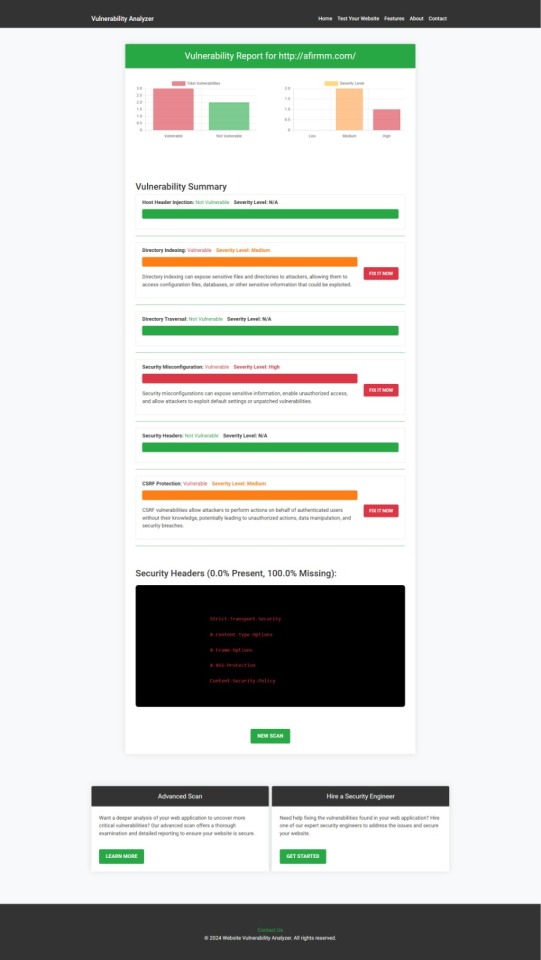
An example of a vulnerability assessment report generated with our free tool provides insights into possible vulnerabilities.
Conclusion: Strengthen Your API Security Today
API vulnerabilities in Laravel are common, but with the right precautions and coding practices, you can protect your web application. Make sure to always sanitize user input, implement strong authentication mechanisms, and use proper route protection. Additionally, take advantage of our tool to check Website vulnerability to ensure your Laravel APIs remain secure.
For more information on securing your Laravel applications try our Website Security Checker.
#cyber security#cybersecurity#data security#pentesting#security#the security breach show#laravel#php#api
2 notes
·
View notes
Text
Startups need agile, scalable, and secure solutions to thrive in today’s competitive landscape. Laravel, with its robust framework, empowers businesses to build dynamic and secure web applications while scaling effortlessly. Its powerful features like Eloquent ORM, built-in security, and seamless API integration make it the ultimate choice for fast-paced growth.
Laravel offers startups a perfect balance of speed, scalability, and security. Its elegant syntax, built-in authentication, and exceptional performance optimization help businesses achieve quick deployment without compromising quality. Whether you're building a new platform or expanding an existing one, Laravel ensures your growth journey is seamless and secure.
3 notes
·
View notes
Text
Laravel Là Gì?
Laravel là một framework PHP mã ngu��n mở được thiết kế để phát triển các ứng dụng web theo kiến trúc MVC (Model-View-Controller). Ra mắt lần đầu vào năm 2011 bởi Taylor Otwell, Laravel nhanh chóng trở thành một trong những framework phổ biến nhất trong cộng đồng lập trình PHP nhờ sự đơn giản, mạnh mẽ và linh hoạt.

Laravel cung cấp một loạt các công cụ và tính năng hữu ích, giúp tăng tốc và tối ưu hóa quá trình phát triển phần mềm. Một số tính năng nổi bật của Laravel bao gồm hệ thống định tuyến mạnh mẽ, ORM (Eloquent) để làm việc với cơ sở dữ liệu, hệ thống migration để quản lý database, và các công cụ tích hợp như Artisan CLI (dòng lệnh) hỗ trợ tự động hóa nhiều tác vụ.
Ngoài ra, Laravel còn hỗ trợ việc bảo mật với các cơ chế như xác thực người dùng, mã hóa, và bảo vệ ứng dụng khỏi các lỗ hổng bảo mật phổ biến (CSRF, SQL Injection). Đặc biệt, Laravel đi kèm với Blade – một công cụ tạo giao diện thân thiện và hiệu quả.
Với hệ sinh thái phong phú như Laravel Forge, Nova, và Envoyer, framework này không chỉ phù hợp cho các ứng dụng nhỏ mà còn mạnh mẽ đủ để phát triển các hệ thống lớn, phức tạp. Laravel là lựa chọn lý tưởng cho các lập trình viên PHP muốn xây dựng các ứng dụng nhanh chóng và chuyên nghiệp.
Nguồn: https://thuegpu.vn/laravel-la-gi-cai-dat-va-cau-hinh-laravel-voi-nginx-tren-ubuntu/
2 notes
·
View notes
Text
Top 5 Common Database Design patterns in Laravel
In the world of Laravel development, a well-structured database is the bedrock of a robust and scalable application. While Laravel's Eloquent ORM provides a powerful abstraction layer for interacting with your data, understanding common database design patterns can significantly enhance your development process.
These patterns not only promote code organization and maintainability but also enable you to adapt your database structure to the unique needs of your application. By mastering these patterns, you can build efficient, reliable, and easily maintainable Laravel applications that can handle diverse data requirements.
1. Active Record Pattern:
This is the most common pattern used by Eloquent ORM in Laravel. It encapsulates database logic within model classes, allowing you to interact with the database using object-oriented methods.
Application
This pattern is well-suited for projects of any size and complexity. It simplifies database operations, making them easier to understand and maintain.
Example:

Advantages:
Simplicity: Easy to understand and implement.
Code Reusability: Model methods can be reused throughout your application.
Relationship Management: Built-in support for relationships between models.
Disadvantages:
Tight Coupling: Model logic is tightly coupled to the database, making it harder to test independently.
Complexity: Can become complex for large applications with complex data structures.
2. Data Mapper Pattern:
This pattern separates data access logic from domain logic. It uses a dedicated "mapper" class to translate between domain objects and database records.
Application
This pattern is useful for large-scale applications with complex domain models, as it allows for greater flexibility and modularity. It is particularly useful when working with multiple data sources or when you need to optimize for performance.
Example:

Advantages:
Flexibility: Easily change the database implementation without affecting business logic.
Testability: Easy to test independently from the database.
Modularity: Promotes a modular structure, separating concerns.
Disadvantages:
Increased Complexity: Requires more code and might be overkill for simple applications.
3. Repository Pattern:
This pattern provides an abstraction layer over the data access mechanism, offering a consistent interface for interacting with the database.
Application
This pattern promotes loose coupling and simplifies testing, as you can easily mock the repository and control the data returned. It is often used in conjunction with the Data Mapper pattern.
Example:

Advantages:
Loose Coupling: Decouples business logic from specific data access implementation.
Testability: Easy to mock repositories for testing.
Reusability: Reusable interface for accessing different data sources.
Disadvantages:
Initial Setup: Can require more setup compared to Active Record.
4. Table Inheritance Pattern:
This pattern allows you to create a hierarchical relationship between tables, where child tables inherit properties from a parent table.
Application
This pattern is useful for creating polymorphic relationships and managing data for different types of entities. For example, you could have a User table and separate tables for AdminUser and CustomerUser that inherit from the parent table.
Example:

Advantages:
Polymorphism: Enables handling different types of entities using a common interface.
Code Reusability: Reuses properties and methods from the parent table.
Data Organization: Provides a structured way to organize data for different types of users.
Disadvantages:
Increased Database Complexity: Can lead to a more complex database structure.
5. Schema-less Database Pattern:
This pattern avoids the use of a predefined schema and allows for dynamic data structures. This is commonly used with NoSQL databases like MongoDB.
Application
This pattern is suitable for projects that require highly flexible data structures, such as social media platforms or analytics systems.
Example:

Advantages:
Flexibility: Easily adapt to changing data structures.
Scalability: Suitable for high-volume, rapidly changing data.
High Performance: Efficient for specific use cases like real-time analytics.
Disadvantages:
Increased Complexity: Requires a different approach to querying and data manipulation.
Data Consistency: Can be challenging to maintain data consistency without a schema.
Choosing the Right Pattern:
The best pattern for your project depends on factors like project size, complexity, performance requirements, and your team's experience. It is important to choose patterns that align with the specific needs of your application and ensure long-term maintainability and scalability.
Conclusion:
This exploration of common database design patterns used in Laravel has shed light on the importance of strategic database structuring for building robust and scalable applications. From the simplicity of the Active Record pattern to the sophisticated capabilities of the Data Mapper and Repository patterns, each pattern offers distinct benefits that cater to specific project needs.
By understanding the strengths and applications of these patterns, Laravel developers can choose the optimal approach for their projects, ensuring a well-organized, efficient, and maintainable database architecture. Ultimately, mastering these patterns empowers you to create Laravel applications that are not only functional but also adaptable to evolving data requirements and future growth.
#laravel#laravel development company#laravel framework#laravel developers#database#design#coding#programming
4 notes
·
View notes
Text
Top 10 Laravel Development Companies in the USA in 2024
Laravel is a widely-used open-source PHP web framework designed for creating web applications using the model-view-controller (MVC) architectural pattern. It offers developers a structured and expressive syntax, as well as a variety of built-in features and tools to enhance the efficiency and enjoyment of the development process.

Key components of Laravel include:
1. Eloquent ORM (Object-Relational Mapping): Laravel simplifies database interactions by enabling developers to work with database records as objects through a powerful ORM.
2. Routing: Laravel provides a straightforward and expressive method for defining application routes, simplifying the handling of incoming HTTP requests.
3. Middleware: This feature allows for the filtering of HTTP requests entering the application, making it useful for tasks like authentication, logging, and CSRF protection.
4. Artisan CLI (Command Line Interface): Laravel comes with Artisan, a robust command-line tool that offers commands for tasks such as database migrations, seeding, and generating boilerplate code.
5. Database Migrations and Seeding: Laravel's migration system enables version control of the database schema and easy sharing of changes across the team. Seeding allows for populating the database with test data.
6. Queue Management: Laravel's queue system permits deferred or background processing of tasks, which can enhance application performance and responsiveness.
7. Task Scheduling: Laravel provides a convenient way to define scheduled tasks within the application.
What are the reasons to opt for Laravel Web Development?
Laravel makes web development easier, developers more productive, and web applications more secure and scalable, making it one of the most important frameworks in web development.
There are multiple compelling reasons to choose Laravel for web development:
1. Clean and Organized Code: Laravel provides a sleek and expressive syntax, making writing and maintaining code simple. Its well-structured architecture follows the MVC pattern, enhancing code readability and maintainability.
2. Extensive Feature Set: Laravel comes with a wide range of built-in features and tools, including authentication, routing, caching, and session management.
3. Rapid Development: With built-in templates, ORM (Object-Relational Mapping), and powerful CLI (Command Line Interface) tools, Laravel empowers developers to build web applications quickly and efficiently.
4. Robust Security Measures: Laravel incorporates various security features such as encryption, CSRF (Cross-Site Request Forgery) protection, authentication, and authorization mechanisms.
5. Thriving Community and Ecosystem: Laravel boasts a large and active community of developers who provide extensive documentation, tutorials, and forums for support.
6. Database Management: Laravel's migration system allows developers to manage database schemas effortlessly, enabling version control and easy sharing of database changes across teams. Seeders facilitate the seeding of databases with test data, streamlining the testing and development process.
7. Comprehensive Testing Support: Laravel offers robust testing support, including integration with PHPUnit for writing unit and feature tests. It ensures that applications are thoroughly tested and reliable, reducing the risk of bugs and issues in production.
8. Scalability and Performance: Laravel provides scalability options such as database sharding, queue management, and caching mechanisms. These features enable applications to handle increased traffic and scale effectively.
Top 10 Laravel Development Companies in the USA in 2024
The Laravel framework is widely utilised by top Laravel development companies. It stands out among other web application development frameworks due to its advanced features and development tools that expedite web development. Therefore, this article aims to provide a list of the top 10 Laravel Development Companies in 2024, assisting you in selecting a suitable Laravel development company in the USA for your project.
IBR Infotech

IBR Infotech excels in providing high-quality Laravel web development services through its team of skilled Laravel developers. Enhance your online visibility with their committed Laravel development team, which is prepared to turn your ideas into reality accurately and effectively. Count on their top-notch services to receive the best as they customise solutions to your business requirements. Being a well-known Laravel Web Development Company IBR infotech is offering the We provide bespoke Laravel solutions to our worldwide customer base in the United States, United Kingdom, Europe, and Australia, ensuring prompt delivery and competitive pricing.
Additional Information-
GoodFirms : 5.0
Avg. hourly rate: $25 — $49 / hr
No. Employee: 10–49
Founded Year : 2014
Verve Systems
Elevate your enterprise with Verve Systems' Laravel development expertise. They craft scalable, user-centric web applications using the powerful Laravel framework. Their solutions enhance consumer experience through intuitive interfaces and ensure security and performance for your business.
Additional Information-
GoodFirms : 5.0
Avg. hourly rate: $25
No. Employee: 50–249
Founded Year : 2009
KrishaWeb

KrishaWeb is a world-class Laravel Development company that offers tailor-made web solutions to our clients. Whether you are stuck up with a website concept or want an AI-integrated application or a fully-fledged enterprise Laravel application, they can help you.
Additional Information-
GoodFirms : 5.0
Avg. hourly rate: $50 - $99/hr
No. Employee: 50 - 249
Founded Year : 2008
Bacancy
Bacancy is a top-rated Laravel Development Company in India, USA, Canada, and Australia. They follow Agile SDLC methodology to build enterprise-grade solutions using the Laravel framework. They use Ajax-enabled widgets, model view controller patterns, and built-in tools to create robust, reliable, and scalable web solutions
Additional Information-
GoodFirms : 4.8
Avg. hourly rate: $25 - $49/hr
No. Employee: 250 - 999
Founded Year : 2011
Elsner
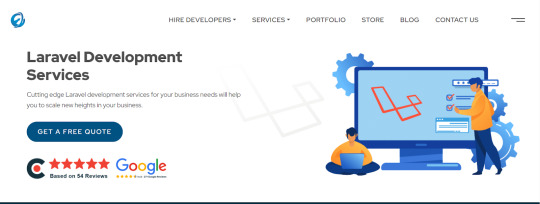
Elsner Technologies is a Laravel development company that has gained a high level of expertise in Laravel, one of the most popular PHP-based frameworks available in the market today. With the help of their Laravel Web Development services, you can expect both professional and highly imaginative web and mobile applications.
Additional Information-
GoodFirms : 5
Avg. hourly rate: < $25/hr
No. Employee: 250 - 999
Founded Year : 2006
Logicspice

Logicspice stands as an expert and professional Laravel web development service provider, catering to enterprises of diverse scales and industries. Leveraging the prowess of Laravel, an open-source PHP framework renowned for its ability to expedite the creation of secure, scalable, and feature-rich web applications.
Additional Information-
GoodFirms : 5
Avg. hourly rate: < $25/hr
No. Employee: 50 - 249
Founded Year : 2006
Sapphire Software Solutions
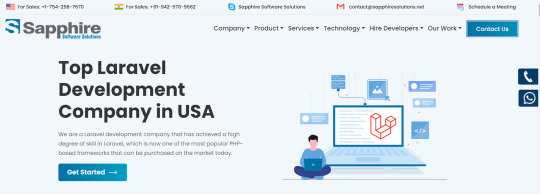
Sapphire Software Solutions, a leading Laravel development company in the USA, specialises in customised Laravel development, enterprise solutions,.With a reputation for excellence, they deliver top-notch services tailored to meet your unique business needs.
Additional Information-
GoodFirms : 5
Avg. hourly rate: NA
No. Employee: 50 - 249
Founded Year : 2002
iGex Solutions
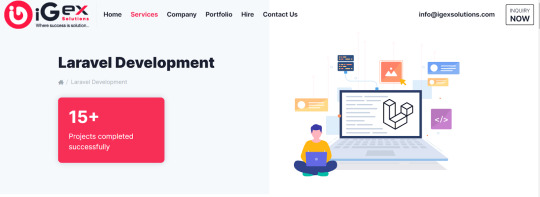
iGex Solutions offers the World’s Best Laravel Development Services with 14+ years of Industry Experience. They have 10+ Laravel Developer Experts. 100+ Elite Happy Clients from there Services. 100% Client Satisfaction Services with Affordable Laravel Development Cost.
Additional Information-
GoodFirms : 4.7
Avg. hourly rate: < $25/hr
No. Employee: 10 - 49
Founded Year : 2009
Hidden Brains
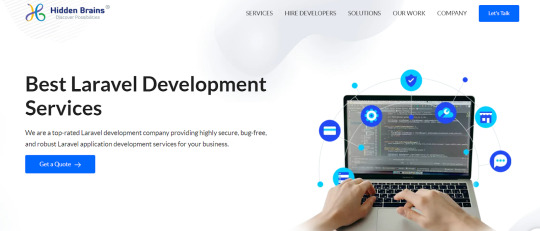
Hidden Brains is a leading Laravel web development company, building high-performance Laravel applications using the advantage of Laravel's framework features. As a reputed Laravel application development company, they believe your web application should accomplish the goals and can stay ahead of the rest.
Additional Information-
GoodFirms : 4.9
Avg. hourly rate: < $25/hr
No. Employee: 250 - 999
Founded Year : 2003
Matellio
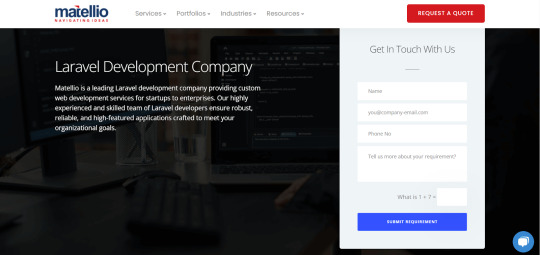
At Matellio, They offer a wide range of custom Laravel web development services to meet the unique needs of their global clientele. There expert Laravel developers have extensive experience creating robust, reliable, and feature-rich applications
Additional Information-
GoodFirms : 4.8
Avg. hourly rate: $50 - $99/hr
No. Employee: 50 - 249
Founded Year : 2014
What advantages does Laravel offer for your web application development?
Laravel, a popular PHP framework, offers several advantages for web application development:
Elegant Syntax
Modular Packaging
MVC Architecture Support
Database Migration System
Blade Templating Engine
Authentication and Authorization
Artisan Console
Testing Support
Community and Documentation
Conclusion:
I hope you found the information provided in the article to be enlightening and that it offered valuable insights into the top Laravel development companies.
These reputable Laravel development companies have a proven track record of creating customised solutions for various sectors, meeting client requirements with precision.
Over time, these highlighted Laravel developers for hire have completed numerous projects with success and are well-equipped to help advance your business.
Before finalising your choice of a Laravel web development partner, it is essential to request a detailed cost estimate and carefully examine their portfolio of past work.
#Laravel Development Companies#Laravel Development Companies in USA#Laravel Development Company#Laravel Web Development Companies#Laravel Web Development Services
2 notes
·
View notes
Text
Laravel 12 makes it easy to build CRUD applications with file and image uploads using its powerful Eloquent ORM and built-in file storage system. In this tutorial, we’ll create a CRUD application where users can upload images along with their data.
By the end of this guide, you will learn: ✅ How to set up a Laravel 12 project ✅ How to create a model, migration, and controller ✅ How to upload and validate images ✅ How to perform CRUD operations (Create, Read, Update, Delete) ✅ How to display images in Blade templates
Let’s get started! 🚀
#Laravel12#CRUD#ImageUpload#Laravel#WebDevelopment#LaravelApp#CRUDOperations#LaravelDevelopment#ImageHandling#PHP#LaravelTutorial#FileUpload#BackendDevelopment#LaravelProjects#WebAppDevelopment#LaravelBestPractices#LaravelCRUD#PHPFramework#LaravelImageUpload#CRUDApp#WebAppFeatures#LaravelFileUpload#DatabaseIntegration#LaravelAppDevelopment#LaravelFileHandling
0 notes
Text
Ultimate Guide to Choosing Between Laravel and Django for Your Next Web App

Building a web application is no small feat. It’s like assembling a spaceship — every component matters, and choosing the wrong framework can send your project into a black hole. At Kanhasoft, we’ve spent years crafting custom software solutions that feel like a secret superpower for our clients. Two of our favorite tools? Laravel and Django, the rockstars of web development frameworks. But which one is the best framework for your web app? Spoiler: there’s no one-size-fits-all answer, but we’re here to break it down so you can make an informed choice.
Whether you’re a startup dreaming of the next big app or an enterprise streamlining operations, this guide will compare Laravel vs Django across performance, scalability, security, and more. Let’s dive into the nitty-gritty and help you pick the perfect framework for your next project.
Why Laravel and Django? The Heavyweights of Web Development
Laravel (PHP-based) and Django (Python-based) are battle-tested frameworks loved by developers and businesses alike. Both power robust, scalable web apps, but they cater to slightly different needs. At Kanhasoft, a software development company with expertise in both, we’ve built everything from eCommerce platforms to data-heavy enterprise systems using these tools. So, why are they so popular?
Laravel: Known for its elegant syntax and rapid development, Laravel is a PHP framework that makes building feature-rich apps a breeze. It’s packed with tools like Eloquent ORM, Blade templating, and built-in authentication.
Django: The Python-powered Django is all about “batteries included,” offering a full-stack ecosystem with ORM, admin panels, and security features out of the box. It’s a favorite for data-driven and rapid-prototyping projects.
Performance: Speed That Keeps Up with Your Ambition
When it comes to performance, both Laravel and Django deliver, but their strengths differ. Laravel, built on PHP, shines in environments with high user traffic, like eCommerce platforms. Its caching tools (e.g., Redis, Memcached) and optimization features ensure snappy response times. At Kanhasoft, we’ve used Laravel to build custom software for marketplaces that handle thousands of transactions daily without breaking a sweat.
Django, on the other hand, leverages Python’s efficiency and excels in CPU-intensive tasks, like data processing or machine learning integrations. Its asynchronous capabilities (introduced in Django 3.1) make it a strong contender for real-time apps. For example, we’ve powered Django web development projects with complex analytics dashboards that crunch numbers in milliseconds.
Verdict: Choose Laravel for user-facing apps with heavy traffic. Go with Django for data-heavy or computation-intensive projects. Need both? A software development company like Kanhasoft can blend their strengths with microservices.
Scalability: Growing Without the Growing Pains
Scalability is where your web app proves it can handle success. Laravel’s modular structure and support for microservices make it a go-to for apps that need to scale horizontally. Think of platforms like Airbnb or Uber — Laravel’s ecosystem (with tools like Laravel Vapor) can support massive user bases. We’ve built scalable Laravel apps at Kanhasoft that seamlessly grew from MVP to enterprise-grade solutions.
Django’s scalability is equally impressive, thanks to its clean architecture and Python’s versatility. Companies like Instagram and Pinterest run on Django, proving it can handle billions of requests. Django’s ability to integrate with cloud platforms (e.g., AWS, Google Cloud) makes it ideal for startups planning to scale fast. Our custom software projects often use Django for rapid prototyping that evolves into robust systems.
Verdict: Both frameworks scale well, but Laravel is better for modular, user-centric apps, while Django suits data-driven, cloud-native systems. Let’s explore another critical factor: development speed.
Development Speed: From Vision to Victory
Time-to-market is a make-or-break factor for startups and enterprises alike. Laravel’s developer-friendly features — like pre-built authentication, routing, and Artisan CLI — accelerate development. Its vibrant community and packages (via Composer) mean you’re never starting from scratch. At Kanhasoft, we’ve used Laravel to deliver custom software in record time, empowering clients to launch ahead of competitors.
Django’s “batteries included” philosophy gives it an edge for rapid prototyping. Its built-in admin panel, form handling, and ORM let developers focus on business logic rather than boilerplate code. For Django web development, we’ve built MVPs in weeks, complete with admin dashboards that clients love tweaking themselves.
Verdict: Laravel is faster for feature-rich apps with complex frontends. Django wins for quick prototypes and data-heavy backends. Your timeline and team’s expertise will tip the scales.
Security: Keeping Your App Fortified
In today’s world, a single security breach can sink your app’s reputation. Laravel and Django both prioritize security, but their approaches differ. Laravel offers built-in protections like CSRF tokens, XSS prevention, and secure authentication. Its regular updates and active community keep vulnerabilities at bay. We’ve used Laravel to build secure eCommerce platforms that handle sensitive payment data with ease.
Django is a security powerhouse, with features like SQL injection prevention, CSRF protection, and automatic escaping of HTML. Its “secure by default” mindset makes it a favorite for industries like healthcare and finance. At Kanhasoft, our Django web development projects often include custom security layers for enterprise clients.
Verdict: Both are secure, but Django’s out-of-the-box protections make it slightly easier for beginners to avoid pitfalls. Laravel’s flexibility suits teams with strong security expertise.
Community and Ecosystem: Support That Powers Progress
A framework’s community can be your lifeline during development. Laravel’s ecosystem is massive, with thousands of packages on Packagist and a thriving community on forums like Laracasts. Need a payment gateway or API integration? Laravel’s got you covered. Our team at Kanhasoft leans on Laravel’s ecosystem to deliver custom software tailored to unique client needs.
Django’s community, while smaller, is equally passionate. Python’s vast ecosystem (e.g., libraries like NumPy, Pandas) makes Django a powerhouse for AI and data-driven apps. The Django REST Framework is a game-changer for API development, and we’ve used it to build seamless integrations for clients.
Verdict: Laravel’s ecosystem is broader for web app features, while Django’s Python roots give it an edge for AI and analytics. Choose based on your app’s niche requirements.
Kanhasoft’s Take: Making Technology Your Superpower
At Kanhasoft, we believe technology should feel like a secret superpower. Whether you choose Laravel or Django, our software development company can turn your vision into reality. Laravel’s elegance powers our eCommerce and marketplace projects, while Django’s versatility drives our AI and ERP solutions. Can’t decide? We’ve even combined both in microservices architectures for clients who want the best of both worlds.
Here’s the thing: the best framework for your web app depends on your goals. If you’re building a user-facing platform with complex features, Laravel’s speed and flexibility are hard to beat. If your app leans on data processing, AI, or rapid prototyping, Django’s ecosystem is your ally. Either way, partnering with a software development company like Kanhasoft ensures your app is built to succeed.
FAQs About Laravel vs Django
Q1: Which is better for startups, Laravel or Django? A: Laravel is ideal for startups needing feature-rich apps with quick market entry, thanks to its rapid development tools. Django suits startups focused on data-driven MVPs or AI integrations, offering fast prototyping and scalability.
Q2: Is Django more secure than Laravel? A: Both are secure, but Django’s “secure by default” features (e.g., automatic SQL injection prevention) make it slightly easier for beginners. Laravel offers robust security with proper configuration, ideal for experienced teams.
Q3: Can Laravel and Django be used together? A: Yes, in a microservices architecture. For example, Kanhasoft has built apps using Laravel for the frontend and Django for data-heavy backends, ensuring the best of both worlds.
Q4: Which framework is faster for web app development? A: Laravel accelerates development for complex, user-facing apps with tools like Artisan. Django is faster for prototypes and data-driven apps due to its built-in admin and ORM.
Q5: How do I choose the best framework for my web app? A: Consider your project’s goals, team expertise, and timeline. Laravel suits eCommerce or modular apps; Django excels in analytics or AI-driven projects. Consult a software development company like Kanhasoft for tailored advice.
Conclusion: Your Web App, Your Superpower
Choosing between Laravel and Django isn’t about picking a winner — it’s about finding the framework that makes your web app a powerhouse. At Kanhasoft, we’ve seen both frameworks transform ideas into reality, from sleek marketplaces to intelligent ERP systems. As a software development company, our mission is to make technology feel effortless, like a superpower you wield with confidence.
So, what’s your next step? Evaluate your project’s needs, weigh the strengths of Laravel vs Django, and let your vision guide you. Better yet, reach out to Kanhasoft for a free consultation. We’ll help you choose the best framework for your web app and build custom software that sets you apart. Let’s make your app the hero of your story — contact us today!
0 notes
Text
Why do you think Laravel is popular among developers?
Laravel is popular among developers for a variety of reasons, both technical and practical. Here's why it stands out:
Elegant Syntax
Laravel offers clean, readable, and expressive syntax, making development faster and more enjoyable.
MVC Architecture
It follows the Model-View-Controller (MVC) pattern, helping developers keep code organized, scalable, and maintainable.
Built-in Tools and Features
Laravel includes powerful built-in tools like Blade Templating Engine, Eloquent ORM for database interaction, Artisan CLI for automating tasks, Routing, Authentication, Queues, Mail, and more
Rapid Application Development
Laravel comes with tools that help in quick prototyping and faster project completion.
Security
It offers robust security features like CSRF protection, password hashing, and SQL injection prevention right out of the box.
Strong Ecosystem
Laravel’s ecosystem includes tools like Laravel Forge (server deployment), Laravel Vapor (serverless deployment), Laravel Nova (admin panel), Laravel Mix (asset compilation)
Huge Community Support
Laravel has a large, active community and excellent documentation, which makes it easy to find help and resources.
Testing Made Easy
Laravel is built with testing in mind and includes PHPUnit support by default, helping developers ensure quality code.
Scalability
With support for microservices and integrations with cloud services, Laravel apps can scale effectively for enterprise use.
API-Ready
Laravel makes it easy to build RESTful APIs or even use it purely as a backend API service.
0 notes
Text
Back-End Development: A Complete Guide for Beginners in 2025
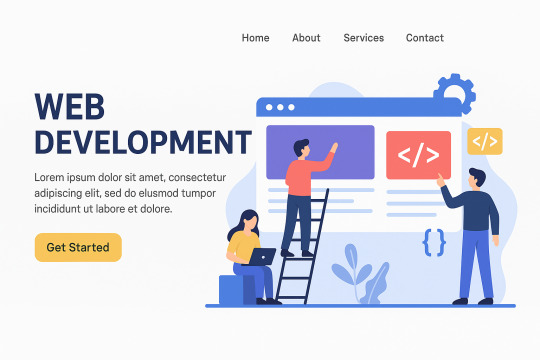
When you visit a website, everything you see—the layout, colors, text, and buttons—is the front end. But what happens when you log in, fill out a form, or make a payment? That’s where the back-end development magic begins.
In this complete guide, we’ll explore what back-end development is, why it’s crucial for the web, what technologies and skills you need, and how you can build a thriving career in this dynamic field. Whether you're a curious beginner or someone switching careers, this article has everything you need to know.
🚀 What is Back-End Development?
Back-end development refers to the server-side part of web development. It's everything that happens behind the scenes to make a website or app function properly—like servers, databases, application logic, and APIs.
Back-end development is all about how a website works rather than how it looks.
For example:
When you submit a login form, the back end checks your credentials in the database.
When you place an order online, the back end processes the order and stores the transaction.
⚙️ How Does Back-End Development Work?
The back end interacts with three key components:
Server – The machine that handles requests.
Database – Where data like user info and product listings are stored.
Application – The logic that ties it all together.
Here’s a simplified flow:
User clicks a button (front-end)
Front-end sends a request to the server
Back-end processes the request
Data is fetched from or saved to the database
Server sends a response back to the front-end
🧰 Core Technologies in Back-End Development
To become a back-end developer, you’ll need to learn these foundational tools and languages:
1. Programming Languages
LanguageUse CaseJavaScript (Node.js)Scalable server-side appsPythonFast prototyping, AI, APIsPHPWordPress and server scriptingRubyElegant, readable server-side codeJavaEnterprise-grade backend systemsC# (.NET)Enterprise, Windows-based applications
2. Databases
TypeExamplesRelationalMySQL, PostgreSQL, MS SQL ServerNoSQLMongoDB, CouchDB, Firebase
3. Frameworks
LanguageFrameworksJavaScriptExpress.js, Nest.jsPythonDjango, FlaskPHPLaravelRubyRuby on Rails
🌐 Back-End vs Front-End Development
FeatureFront-EndBack-EndFocusUser interface (UI/UX)Server logic and databaseLanguagesHTML, CSS, JSJS (Node), Python, PHP, JavaRuns OnBrowserServerPrimary ConcernDesign, interactivityLogic, data management, securityPopular ToolsReact, Vue, BootstrapDjango, Express.js, PostgreSQL
🧑💻 Roles & Responsibilities of a Back-End Developer
What does a back-end developer do?
Build APIs and server-side logic
Design and maintain databases
Secure user data and handle authentication
Ensure scalability and performance
Collaborate with front-end developers and DevOps teams
🛡️ Back-End and Security
Security is a core responsibility in back-end development.
Key areas include:
Data encryption
Secure APIs
Password hashing (bcrypt, Argon2)
Input validation
Authorization & Authentication (OAuth, JWT, etc.)
🧱 APIs and RESTful Architecture
APIs (Application Programming Interfaces) are bridges between the front end and back end.
Back-end developers often design:
REST APIs using HTTP methods (GET, POST, PUT, DELETE)
GraphQL APIs for flexible data querying
WebSockets for real-time communication
🔗 Database Management and ORM
Databases are the heart of any application.
Back-end developers use SQL for structured queries and ORMs (Object Relational Mappers) like:
Sequelize (Node.js)
Prisma
SQLAlchemy (Python)
Eloquent (Laravel)
📦 Hosting and Deployment
Once the server code is ready, it needs to be hosted.
Popular options:
Cloud: AWS, Google Cloud, Azure
Containers: Docker, Kubernetes
Serverless: Vercel, Netlify, AWS Lambda
CI/CD pipelines like GitHub Actions, Jenkins, and GitLab CI automate deployments.
🧠 Learning Path: How to Become a Back-End Developer
Here’s a structured roadmap:
Master a Programming Language – Start with Python or JavaScript (Node.js)
Understand the Internet and HTTP
Learn Databases – Start with MySQL or MongoDB
Build REST APIs
Practice Authentication & Security
Work with Real Projects
Use Git and GitHub
Explore DevOps Basics
Build a Portfolio with back-end apps
Contribute to Open Source
📊 Salary Insights and Job Opportunities (2025)
Back-end development is one of the most in-demand tech skills in 2025.CountryEntry-LevelMid-LevelSeniorIndia₹5–8 LPA₹10–20 LPA₹25+ LPAUSA$65K–$85K$90K–$120K$130K+UK£30K–£50K£55K–£75K£80K+
Common Job Titles:
Back-End Developer
Full-Stack Developer
API Engineer
Server-Side Developer
Cloud Functions Developer
💬 Real Developer Reviews
⭐⭐⭐⭐⭐ “As a back-end developer, I love building things people don’t even realize they’re using. It’s like being a wizard behind the curtain.” — Neha R., Software Engineer
⭐⭐⭐⭐☆ “Python and Django made it easy to get started. The logic is so clean and powerful.” — Mike T., Backend Developer
⭐⭐⭐⭐⭐ “Every startup needs someone who can build scalable back ends. It’s a career with massive growth potential.” — Ritika D., API Architect
🧠 Best Learning Resources (Free & Paid)
Free Platforms:
freeCodeCamp
MDN Web Docs
The Odin Project
Paid Options:
Udemy
"Node.js: The Complete Guide"
"Python & Django Bootcamp"
Coursera
"Back-End Development by Meta"
edX
Scrimba
📌 FAQs About Back-End Development
Q1. Do I need a degree to become a back-end developer?
A: No. Many successful developers are self-taught. Bootcamps and real-world projects matter more than degrees.
Q2. Which is better: back-end or front-end?
A: It depends on your interests. If you enjoy logic, data, and server operations—back-end is for you.
Q3. Is Node.js good for back-end?
A: Yes. Node.js is fast, efficient, and widely used for scalable server-side applications.
Q4. How long does it take to become job-ready?
A: With consistent learning, you can become a back-end developer in 6–12 months.
Q5. What is full-stack development?
A: Full-stack developers handle both front-end and back-end tasks. They’re skilled in end-to-end development.
Q6. What are the best languages for back-end development?
A: Python, JavaScript (Node.js), PHP, Java, and C# are top choices in 2025.
✨ Final Thoughts: Is Back-End Development Right for You?
If you love building logic, handling real-world data, working with APIs, and ensuring applications run smoothly—back-end development might be your ideal career path.
It’s a high-demand, well-paying, and technically rewarding field with endless opportunities for growth, especially with cloud computing, AI, and big data booming.
Whether you dream of joining a tech giant or launching your own SaaS app, mastering back-end development opens the door to some of the most impactful tech roles of the future.
0 notes
Text
Why Headless Laravel CMS is Taking Over Traditional Web Development
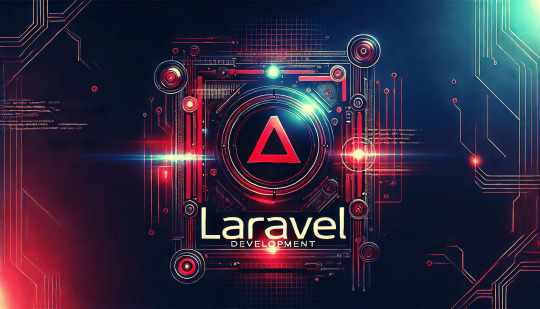
Hey folks! 🚀 If you’ve been keeping up with web development trends, you’ve probably heard the buzz about headless Laravel CMS. It’s revolutionizing how we build and manage websites, leaving traditional CMS platforms like WordPress and Drupal in the dust. But why? Let’s dive in and explore why businesses and developers are making the switch—spoiler alert: it’s all about flexibility, speed, and scalability!
Understanding Headless Laravel CMS and Its Growing Popularity
A headless CMS isn’t some futuristic tech—it’s a smarter way to manage content. Unlike traditional CMS platforms that bundle the frontend and backend together, a headless CMS decouples them, giving developers the freedom to use any frontend framework while Laravel handles the backend like a pro.
What is a Headless CMS and How Does It Work?
Imagine a restaurant where the kitchen (backend) and dining area (frontend) operate independently. 🍽️ The kitchen prepares the food (content), and the waitstaff (APIs) deliver it to any dining setup—be it a food truck, rooftop café, or home delivery. That’s how a headless CMS works! It stores and manages content, then delivers it via APIs to any device or platform—websites, mobile apps, smartwatches, you name it.
Why Laravel is Perfect for a Headless CMS
Laravel isn’t just another PHP framework—it’s a powerhouse for API-driven development. With built-in support for RESTful and GraphQL APIs, Eloquent ORM for smooth database interactions, and a robust ecosystem, it’s no wonder Laravel is the top pick for headless CMS setups.
Headless Laravel CMS vs. Traditional CMS Solutions
Traditional CMS platforms like WordPress are great for simple websites, but they struggle with scalability and multi-channel content delivery. A headless Laravel CMS, on the other hand, offers:
No frontend restrictions (use React, Vue.js, or even a mobile app).
Better performance (no bloated themes or plugins slowing things down).
Future-proof flexibility (adapt to new tech without overhauling your backend).
Benefits of Using a Headless CMS with Laravel
Enhanced Performance and Scalability
Did you know? Websites using headless CMS architectures load up to 50% faster than traditional setups. 🏎️ By separating the frontend and backend, Laravel ensures your content is delivered lightning-fast, whether you’re serving 100 or 100,000 users.
Multi-Platform Content Delivery
With a headless Laravel CMS, your content isn’t tied to a single website. Publish once, and distribute everywhere—web, mobile apps, IoT devices, even digital billboards! Companies like Netflix and Spotify use headless CMS to deliver seamless experiences across platforms.
Improved Security and Backend Control
Traditional CMS platforms are hacker magnets (looking at you, WordPress plugins!). A headless Laravel CMS reduces vulnerabilities by:
Limiting exposure (no public-facing admin panel).
Using Laravel’s built-in security (CSRF protection, encryption).
Offering granular API access control.
Key Technologies Powering Headless Laravel CMS
RESTful and GraphQL APIs in Laravel CMS
Laravel makes API development a breeze. Whether you prefer REST (simple and structured) or GraphQL (flexible and efficient), Laravel’s got you covered. Fun fact: GraphQL can reduce API payloads by up to 70%, making your apps faster and more efficient.
Integrating Laravel CMS with JavaScript Frontend Frameworks
Pairing Laravel with React, Vue.js, or Next.js is like peanut butter and jelly—perfect together! 🥪 Frontend frameworks handle the UI, while Laravel manages data securely in the background. Many Laravel web development companies leverage this combo for high-performance apps.
Database and Storage Options for Headless Laravel CMS
Laravel plays nice with MySQL, PostgreSQL, MongoDB, and even cloud storage like AWS S3. Need to scale? No problem. Laravel’s database abstraction ensures smooth performance, whether you’re running a blog or a global e-commerce site.
Use Cases and Real-World Applications of Headless Laravel CMS
E-Commerce and Headless Laravel CMS
E-commerce giants love headless CMS for its agility. Imagine updating product listings once and seeing changes reflected instantly on your website, mobile app, and marketplace integrations. Companies like Nike and Adidas use headless setups for seamless shopping experiences.
Content-Heavy Websites and Laravel Headless CMS
News portals and media sites thrive with headless Laravel CMS. Why? Because journalists can publish content via a streamlined backend, while developers use modern frameworks to create dynamic, fast-loading frontends.
API-Driven Web and Mobile Applications
From fitness apps to banking platforms, headless Laravel CMS ensures real-time data sync across devices. No more clunky updates—just smooth, consistent user experiences.
Challenges and Best Practices for Headless Laravel CMS
Managing API Requests Efficiently
Too many API calls can slow things down. Solution? Caching and webhooks. Laravel’s caching mechanisms (Redis, Memcached) and event-driven webhooks keep performance snappy.
Handling SEO in a Headless Laravel CMS Setup
SEO isn’t dead—it’s just different! Use server-side rendering (SSR) with Next.js or Nuxt.js, and leverage Laravel’s meta-tag management tools to keep search engines happy.
Ensuring Smooth Frontend and Backend Communication
Clear API documentation and webhook integrations are key. A well-structured Laravel backend paired with a modular frontend ensures seamless updates and maintenance.
Final Thoughts
Headless Laravel CMS isn’t just a trend—it’s the future. With better performance, unmatched flexibility, and ironclad security, it’s no surprise that Laravel development companies are leading the charge. Whether you’re building an e-commerce platform, a content hub, or a multi-platform app, going headless with Laravel is a game-changer.
Key Takeaways
Headless Laravel CMS = Speed + Flexibility 🚀
API-first architecture = Content everywhere 📱💻
Security and scalability built-in 🔒
Frequently Asked Questions (FAQs)
1. What is the difference between a traditional CMS and a headless CMS?
A traditional CMS (like WordPress) combines the backend (content management) and frontend (display) in one system. A headless CMS decouples them, allowing content to be delivered via APIs to any frontend—websites, apps, or even smart devices. This offers greater flexibility and performance.
2. Why should I use Laravel for a headless CMS?
Laravel’s robust API support, security features, and scalability make it ideal for headless CMS setups. Its ecosystem (including tools like Laravel Sanctum for API auth) simplifies development, making it a top choice for Laravel web development services.
3. Can I integrate Laravel’s headless CMS with React or Vue.js?
Absolutely! Laravel works seamlessly with JavaScript frameworks like React, Vue.js, and Next.js. The backend serves content via APIs, while the frontend framework handles the UI, creating a fast, dynamic user experience.
4. How does a headless CMS improve website performance?
By separating the frontend and backend, a headless CMS reduces server load and eliminates bloated themes/plugins. Content is delivered via optimized APIs, resulting in faster load times and better scalability.
5. Is SEO more challenging in a headless CMS setup?
Not if you do it right! Use server-side rendering (SSR) with frameworks like Next.js, implement proper meta tags, and leverage Laravel’s SEO tools. Many headless CMS sites rank just as well—or better—than traditional ones.
There you have it, folks! 🎉 Headless Laravel CMS is reshaping web development, and now you know why. Ready to make the switch?
#headless Laravel CMS#headless CMS Laravel#Laravel API backend#Laravel content management#Laravel for headless websites#Laravel vs traditional CMS#modern web development Laravel#Laravel frontend frameworks#Laravel headless architecture#decoupled Laravel CMS
0 notes
Text
Freelance CRM Developer: Improve Customer Relationships with PHP Laravel Developer

Keeping solid client relationships is more crucial than ever in the cutthroat business world of today. An effective tool for managing interactions, tracking customer data, and improving customer satisfaction is a customer relationship management (CRM) system. PHP Laravel Developer has experience creating unique CRM systems that help you interact with your clients more successfully if you're looking for a freelance CRM developer to construct or enhance your CRM system.
Businesses can gain important insights into the preferences, purchasing habits, and behavior of their customers by implementing a CRM system. Businesses can use this data to create more individualized marketing campaigns, enhance customer support, and expedite sales procedures. But not every company needs a CRM solution that works for everyone. Meeting certain business needs requires customization, which is where a freelance CRM developer from PHP Laravel Developer may be really helpful.
Our specialty at PHP Laravel Developer is using the Laravel framework to create unique CRM systems. Laravel is the best option for creating dependable and scalable CRM apps because of its strong features, which include Eloquent ORM, Blade templating engine, and integrated security. As a freelance CRM developer, we make sure your CRM system is flawlessly integrated with your business procedures so you can effectively and effortlessly manage your client interactions.
Customizing the CRM to meet your unique business needs is one of the key advantages of working with a freelance CRM developer from PHP Laravel Developer. We collaborate closely with you to create a system that supports your goals, whether you require sophisticated customer segmentation, lead management, sales forecasting, or marketing automation. In order to create a CRM system that is efficient, user-friendly, and intuitive, we take the time to comprehend your company's objectives.
Another crucial aspect in which PHP Laravel Developer shines is integration. In order to handle customer data, businesses frequently employ a variety of platforms and tools. To maximize productivity, these tools must be integrated into a single, cohesive CRM system. We have expertise integrating several third-party solutions, including social media channels, payment gateways, and email marketing platforms, into your CRM as a freelance CRM developer, guaranteeing that all of your customer interactions are recorded in one location.
Since CRM systems handle sensitive client data, security is of utmost importance. Strong security measures like encryption and authentication are offered by Laravel to shield your data from online attacks. All of our CRM projects at PHP Laravel Developer adhere to the strictest security guidelines, guaranteeing that your client information is always secure and private.
Additionally, a PHP Laravel Developer freelance CRM developer can offer your CRM system continuing support and upkeep. For your CRM solution to last a long time, regular updates, performance optimization, and troubleshooting are essential. Our staff is available to assist you in modifying your CRM system as your company grows and client demands shift.
Furthermore, PHP Laravel Developer offers fast and reasonably priced freelance CRM development services. Compared to big development organizations, working with a freelancer offers you a more individualized approach, quicker delivery times, and cheaper prices. We guarantee that the CRM system we provide for you will be high-quality, reasonably priced, and a good return on your investment.
In conclusion, you may greatly improve your business processes and manage client interactions with a custom CRM system created by a freelance CRM developer from PHP Laravel Developer. We make sure your CRM system satisfies the particular requirements of your company by utilizing Laravel's robust features and putting an emphasis on customization, integration, and security. To create a CRM system that improves client interaction and propels business expansion, collaborate with a PHP Laravel developer right now.
0 notes
Text
Laravel Expert in Pune
Looking for a Laravel expert in Pune? Associative, a leading software company in Pune, specializes in Laravel development, offering custom web solutions for businesses of all sizes.
Laravel Expert in Pune – Transforming Ideas into Scalable Web Solutions
In today's digital era, having a robust and scalable web application is crucial for business success. If you are looking for a Laravel expert in Pune, Associative is your go-to solution. As a trusted software company, we provide top-notch Laravel development services tailored to your business needs.

Why Choose Laravel for Your Web Development?
Laravel is a powerful and widely used PHP framework known for its efficiency, security, and flexibility. It enables rapid development while ensuring a seamless user experience. Here’s why Laravel stands out:
MVC Architecture – Provides a structured coding approach, making development faster and more efficient.
Blade Templating Engine – Simplifies UI design with reusable components.
Eloquent ORM – Offers a seamless database interaction experience.
Security Features – Built-in security mechanisms, such as CSRF protection and encrypted passwords.
Scalability & Performance – Ideal for startups to enterprise-level applications.
Laravel Development Services at Associative
At Associative, we offer a range of Laravel development services to help businesses achieve their digital goals. Our expert Laravel developers in Pune specialize in:
Custom Laravel Web Application Development – Building tailored solutions to meet your specific business requirements.
Laravel E-commerce Development – Developing scalable and feature-rich online stores.
Laravel API Development & Integration – Creating and integrating RESTful APIs for seamless data exchange.
Migration & Upgradation Services ��� Upgrading legacy applications to the latest Laravel versions.
Laravel Maintenance & Support – Ensuring your application remains secure and up-to-date.
Our Expertise Beyond Laravel
At Associative, we specialize in a wide range of technologies to cater to diverse business needs:
Mobile App Development (Android, iOS, Flutter, React Native)
Web Development (Magento, WordPress, Joomla, Drupal, OpenCart, Shopify, BigCommerce)
Java & Spring Boot Development
Node.js, React.js, Express.js Development
Blockchain & Web3 Solutions
Cloud Computing (AWS, GCP)
Game Development (Unreal Engine, C++)
SEO & Digital Marketing Services
Why Choose Associative as Your Laravel Expert in Pune?
Experienced Laravel Developers – A team of skilled professionals with hands-on expertise in Laravel.
Customized Solutions – Tailored web applications designed for performance and scalability.
End-to-End Development – From conceptualization to deployment and maintenance.
Cost-Effective Services – High-quality solutions at competitive pricing.
Client-Centric Approach – We prioritize client requirements and business goals.
Get in Touch with Us
If you're searching for a Laravel expert in Pune, Associative is here to help. Whether you need a custom web application, an e-commerce platform, or API integration, our team is ready to deliver top-notch solutions.
youtube
0 notes
Text
Affordable PPC advertising services for small businesses
Laravel Customized Portal Development Services – Config Infotech
Introduction to Laravel Customized Portal Development
In today's digital world, companies need scalable, secure, and strong web solutions to address their business requirements. Laravel, a highly powerful PHP framework, is a preferred choice for building customized portals that improve business efficiency and user experience. Config Infotech offers Laravel customized portal development services, providing customized solutions that meet the specific needs of businesses from various industries.
Our skilled Laravel programmers create high-performance, feature-rich portals that enable enterprises to automate operations, streamline workflow, and boost customer interaction. Whether you are looking to create a business management portal, eCommerce portal, customer relationship management (CRM) system, or employee management portal, our developers facilitate smooth development and deployment.
Why Laravel is Best Suited for Custom Portal Development?
Laravel is an extremely flexible, open-source PHP framework that boasts security, scalability, and features that are very developer-friendly. The following are some of the reasons why Laravel is perfect for creating customized portals:
MVC Architecture – Laravel uses the Model-View-Controller (MVC) architecture pattern, ensuring clean code structure and maintenance is easier.
Built-in Authentication & Security – Laravel has strong security features that defend against SQL injection, cross-site request forgery, and other security attacks.
Blade Templating Engine – Facilitates UI development with reusable templates.
Eloquent ORM – Simplifies database interactions through an object-relational mapping (ORM) system.
Seamless Third-Party Integration – Laravel makes it easy to integrate APIs, payment gateways, and external applications.
Scalability & Performance Optimization – Guarantees that your portal remains responsive and efficient even as your business expands.
Our Laravel Customized Portal Development Services
We, at Config Infotech, offer full-cycle Laravel portal development solutions to ensure your business receives a rich-featured, tailored solution. Our solutions are:
Business Process Automation Portals
We create automated business management portals that assist businesses in workflow automation, increased productivity, and collaboration between teams. These portals may incorporate modules such as project management, task assignment, reporting, and communication.
Custom eCommerce Portals
Our team is eCommerce portal development experts on Laravel. We implement secure payment gateways, product filtering with advanced features, inventory management, and easy-to-use dashboards to improve shopping.
Customer Relationship Management (CRM) Portals
Config Infotech develops custom CRM solutions that assist companies in handling customer interactions, lead tracking, and streamlining sales processes. Customer segmentation, automated follow-up, analytics, and customized marketing tools are among the features.
Employee & HR Management Portals
We create employee and HR management portals with features such as employee attendance tracking, payroll management, performance evaluation, and internal communication tools for streamlined workforce management.
Healthcare & Telemedicine Portals
We build HIPAA-compliant Laravel-based healthcare portals for healthcare companies that have patient management systems, appointment scheduling, telemedicine consultation, and electronic health records (EHR) management.
Learning Management Systems
Config Infotech designs scalable Learning Management Systems (LMS) that enable online education and corporate training. Our LMS offerings are inclusive of course management, student tracking, assessment tools, and real-time analytics.
Real Estate & Property Management Portals
We provide bespoke real estate portals enabling property listings, virtual tours, tenant management, and payment processing for real estate companies and property managers.
Job Portals & Recruitment Platforms
Our employment portals built in Laravel feature functionalities such as posting jobs, profiles of candidates, parsing resumes, matchmaking based on AI, and employer dashboards.
Finance & Accounting Portals
We develop reliable financial portals for automatic invoicing, tax deduction, financial report generation, and multiple currency processing for companies undertaking global operations.
Most Important Features of Our Laravel Portals
Easy-to-Use Dashboard – User-friendly dashboard for simple accessibility and management.
Multi-User Roles & Access Control – Allow the definition of user roles and access permissions to secure access.
API Integration – Smooth integration with third-party services such as payment gateways, SMS, and email notifications.
SEO-Friendly URLs & Performance Optimization – Improves visibility and enhances speed.
Real-time Data Processing & Analytics – Facilitates data-driven business decisions.
Responsive & Mobile-Friendly Design – Designed for desktop and mobile devices.
Multi-Language & Multi-Currency Support – Suitable for international businesses.
Regular Maintenance & Support – Regular technical support for hassle-free operations.
Our Laravel Development Process
At Config Infotech, we implement a systematic development process to ensure quality and on-time delivery:
Requirement Analysis – Getting to know your business objectives, target segment, and requirements.
Planning & Wireframing – Developing a roadmap, defining the architecture, and creating wireframes.
Development & Integration – Writing clean code, making it scalable, and integrating required features.
Testing & Quality Assurance – Performing thorough testing for performance, security, and usability.
Deployment & Training – Deployment of the portal and training for its effective usage.
Maintenance & Upgrades – Providing post-launch support, routine updates, and feature additions.
Why Opt for Config Infotech for Laravel Customized Portal Development?
Experienced Laravel Developers – Our developers possess years of experience in Laravel development.
Custom Solutions for Every Business – We provide customized solutions as per your individual business requirements.
End-to-End Development – From ideation to deployment and maintenance, we do it all.
Affordable Pricing – Solutions at affordable costs without any compromise on quality.
100% Client Satisfaction – We provide the best service and customer satisfaction.
0 notes